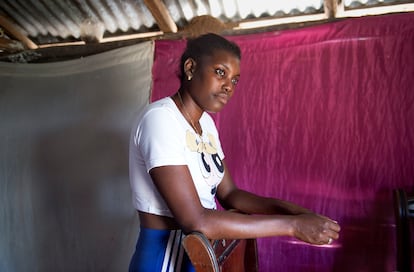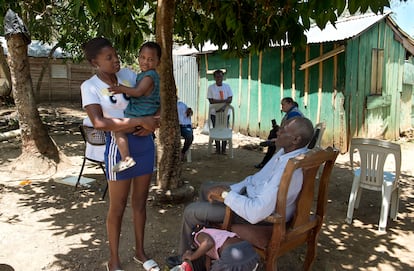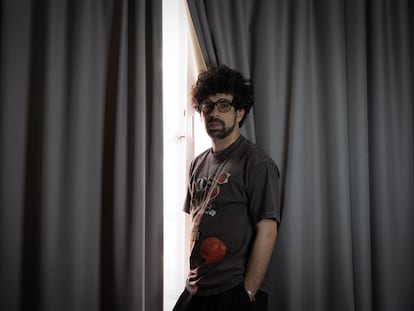The reality of teenage pregnancy in the Dominican Republic: ‘I didn’t finish high school. Now, I’m paying the price’
Early pregnancies and marriage are weighing down on the future of young women in the Caribbean country. At least 20% of girls between the ages of 15 and 19 are mothers. In addition to dealing with health risks, more than half of these young mother are forced to abandon their studies


The United Nations Population Fund (UNFPA) reports that women suffer from “demographic anxiety.” In the heavily-populated Global South, women are pressured to have fewer children, while in more prosperous countries – which have declining birth rates – women are encouraged to have more.
In the case of the Dominican Republic – which has the fertility rate of a rich country, at 2.2 children per woman – there is great concern about the high proportion of teenage pregnancies, as well as maternal mortality, which is closely related to childbirth at an early age. The latest data from the National Statistics Office of the Dominican Republic reveals that 20.4% of girls between the ages of 15 and 19 are mothers in the Caribbean country. This is higher than the 18% average across Latin America and the Caribbean.
Yésica Prensa – a 26-year-old Dominican citizen – has suffered many anxieties related to motherhood in the last decade. Her life exemplifies almost all the forms of women’s suffering that the UNFPA denounced in its latest annual report. She became a wife and adolescent mother, unable to decide when to have children and how many to have. She was never provided with correct information about contraceptives in a country that prohibits abortion.
Prensa lost her first child only two months after giving birth. She eventually had three more; she dropped out of school and her partner abandoned her. Today, lacking adequate care and support, she is unable to earn an income.
She was born in Mata los Indios – a rural community full of sugar plantations, where the residents are of Haitian descent – where some 200 people live. It’s a 90-minute drive north of the capital of Santo Domingo, far from the beachside paradises that attracted more than seven million tourists in 2022 alone. In this town – from which Prensa has never left – the houses are made of wooden planks and tin roofs. There are unpaved roads and few economic opportunities. The latest breach of her human rights has been an attempted rape in her own home, which she has reported to the police. “It happened last night,” she tells EL PAÍS.
“I got married when I was 16 and my husband wanted to have children,” she explains. A year later, her first child was born. She says that she knew about the existence of contraceptive methods, but shrugs her shoulders when asked why she became a mother sooner than she wanted. For too many Dominican women, choosing is not an option: 23% are not free to make decisions about their own bodies in relation to sexual relations or the use of contraceptives, to which 46% do not have access.
Sterilization has been a widely-used method in the Dominican Republic, with 30.5% of women of reproductive age being married or in a domestic partnership, according to a national survey. But this is not always an informed choice: 25% of Dominican women who have undertaken the procedure did so without knowing that it was an irreversible intervention.
“Men tell [their partners] that if they don’t have sex with them, they’ll go off with other women. And in the end, faced with that psychological pressure, women agree,” explains Yaquelín Félix, project coordinator for the Nursing Development Foundation (Fuden), who works in rural communities. “First, the girls have to know that they can say no and their partners will have to accept it.”

Félix’s fight to reduce adolescent pregnancy and associated maternal mortality is also a fight against myths, taboos and misinformation surrounding contraceptive methods. “Many girls don’t tell their parents that they’re having [sexual relations]… therefore, they cannot have birth control pills in the house. The intradermal method (an implant in the arm) is the most appropriate in these cases, but some ask us to remove them after putting it on. [This method] can cause irregularities in their menstruation; they think they’re sick and [worry about] the amount of blood.”
Adolescents who become pregnant are more likely to suffer from complications in pregnancy and childbirth, which are the leading causes of death among young women between the ages of 15 to 19 in the world, according to the UNFPA. With 107 deaths per 100,000 live births, maternal mortality in the Dominican Republic is disproportionately high for an upper-middle-income country, as well as above the average rate of 88 per 100,000 in Latin America and the Caribbean. This is despite the fact that, in the DR, 98% of deliveries are attended to by qualified personnel.
Babies born to teenage mothers are more prone to health problems and even death. In the case of Prensa, these fatal statistics came true. “[My son] died a few weeks after birth. They sent me home and I felt that something was wrong.” She took the baby to the doctor, but nothing could be done. The doctor also told her that she would not be able to have any more children. “He was wrong.”
Tall, thin and elegant, Prensa – through smiles and tears – narrates her life with subtle gestures, while her two youngest children demand attention. Sitting in the shade next to her modest home with two rooms – one for sleeping and the other for cooking – she sobs as she plunges into thoughts about what could have been. “I always said that I would study law,” she sighs, wiping away tears.
Once again, Prensa is the face behind the data of another consequence brought about by teenage pregnancy: an inability to complete secondary education. In the Dominican Republic, only 45.9% of girls who become mothers between the ages of 15 and 19 attend high school or university, compared to 89.8% of teenage girls who have never given birth. “This inequality has an impact, [resulting in] fewer opportunities for their development,” notes Teresa María Guerrero, a researcher at the Dominican Institute for Educational Quality Evaluation and Research.

“I didn’t finish high school. Now, I’m paying the price. I could have had a profession,” Prensa laments. “I would like to work,” she says, with tears in her eyes. But when asked if she could ever resume her studies, she shakes her head. “I can’t.”
She rocks Dylan – the youngest of her children, who is about to turn two – and sits him on her lap. “I have no one to take care of them.” Even if she had some support at home to take care of her children, she wouldn’t be able to afford restarting her studies. In addition to tuition, she would have to pay at least $7 a day to commute between her town and the city of Monte Plata, where adult education is provided. She doesn’t have the money.
“Her story isn’t rare,” says Micaela Parras, program manager at the Spanish Agency for International Development Cooperation (AECID) in the Dominican Republic, which supports projects led by local organizations so that there are fewer cases like Prensa’s. “It’s evidence of the inequality of women [in this country]… in all possible ways, they are denied their rights.”
Prensa’s reality is so common and persistent that, in a 2018 study by the UNFPA, it was revealed that the cost of teenage pregnancy and early motherhood in the Dominican Republic amounted to a yearly cost of $240 million. This figure is the sum of health care expenses and the economic fallout of non-existent job placement for young mothers who, on average, earn a fifth less than women who gave birth when they were adults.
Trapped in a circle of poverty and knowing firsthand the costs of early motherhood, Prensa often speaks to young women in her community, advising them to postpone motherhood and not abandon their education.
“They tell me, ‘who are you to give me advice?’ [Because] I stopped school and devoted myself to giving birth to children.” But Prensa envisions a prosperous future for her little ones. “I want them to study, to be somebody in life, so they don’t have to go through what I’ve been through.”
Her mother died and her father abandoned the household. With no family support other than that of her grandfather – a pastor in Mata los Indios – Prensa has sent her eldest son (who is seven) to live with some uncles. Then came Keisa, who, at the age of three, runs around her mother. Having fulfilled her dream of having a little girl, Prensa didn’t want any more children. She opted for birth control – provided free of charge at the local health center – but soon became pregnant again. Instead of taking the pill on a daily basis, she took it every other day, only when her partner was over for the night. “I thought it was still going to work, but it didn’t.”

Today, she caresses the bulge that is a contraceptive implant in her left arm. “The gynecologist recommended it to me – my mother-in-law told me it was safe.” This method is effective for three years. “When it’s over, I’ll put in another one,” she says determinedly.
Despite professing great concern over the high number of teenage pregnancies, the government of the Dominican Republic – in line with the country’s religious and conservative sectors – recently repealed a 2019 law (which was never properly implemented) that introduced instruction about general equality and reproductive health into the national high school curriculum.
“Many schools plead that we go and give talks on the subject, because the girls get pregnant,” Félix notes. According to the local press – which cites data from the Ministry of Education released this year – “at least 1,154 students [in the country] are pregnant this school year, of which 112 have been victims of rape and 28 of incest.”

For development worker Micaela Parras – from the AECID, which contributed to the report on teenage pregnancy – “it is fundamental” to support healthcare personnel and organizations that work in “invisible and excluded” rural communities, where most teenage pregnancies occur. For the period of 2019 until 2024, the Spanish entity has allocated $3.5 million to support women in these communities. Of that amount, Fuden – the Nursing Development Foundation – is set to receive $200,000 to train nurses who will, in turn, give workshops to advocates for community health. Adequate family planning information will be made available to the local populations, especially to the youngest women and girls.
“The country is made up of communities and, by intervening in them, we’ll achieve a massive effect to change the country,” Félix emphasizes. She is the coordinator of this project.
“At school, the teacher explained something to us… but if it had been up to my mother, I wouldn’t know anything,” admits Yohanni Beras Pérez, a community leader in Mata los Indios. She has had a very different life from that of her friend Prensa. Witnessing the mistreatment suffered by her older sisters – who were both married at an early age – she decided that she didn’t want that kind of life. Instead, she focused all her efforts on studying. Oftentimes going without meals, she managed to finish nursing school and now works in the emergency department of a hospital. In her community, she is now a leader… but also an exception.
Sign up for our weekly newsletter to get more English-language news coverage from EL PAÍS USA Edition
Tu suscripción se está usando en otro dispositivo
¿Quieres añadir otro usuario a tu suscripción?
Si continúas leyendo en este dispositivo, no se podrá leer en el otro.
FlechaTu suscripción se está usando en otro dispositivo y solo puedes acceder a EL PAÍS desde un dispositivo a la vez.
Si quieres compartir tu cuenta, cambia tu suscripción a la modalidad Premium, así podrás añadir otro usuario. Cada uno accederá con su propia cuenta de email, lo que os permitirá personalizar vuestra experiencia en EL PAÍS.
¿Tienes una suscripción de empresa? Accede aquí para contratar más cuentas.
En el caso de no saber quién está usando tu cuenta, te recomendamos cambiar tu contraseña aquí.
Si decides continuar compartiendo tu cuenta, este mensaje se mostrará en tu dispositivo y en el de la otra persona que está usando tu cuenta de forma indefinida, afectando a tu experiencia de lectura. Puedes consultar aquí los términos y condiciones de la suscripción digital.
More information
Archived In
Últimas noticias
Maduro pleads not guilty before the federal court in New York: ‘I am still the president of Venezuela’
A new test can detect Alzheimer’s from a finger prick
UN team enters Sudanese city of El Fasher after paramilitary massacre: ‘It’s like a ghost town’
A recipe for resistance: Indigenous peoples politicize their struggles from the kitchen
Most viewed
- Gilles Lipovetsky: ‘If you want to live better and fall in love, take Prozac, don’t look to philosophy’
- Alain Aspect, Nobel laureate in physics: ‘Einstein was so smart that he would have had to recognize quantum entanglement’
- Alvin Hellerstein, a 92-year-old judge appointed by Bill Clinton, to preside over Maduro’s trial in New York
- Why oil has been at the center of Venezuela-US conflicts for decades
- Maduro’s downfall puts China’s relationship with Venezuela to the test










































